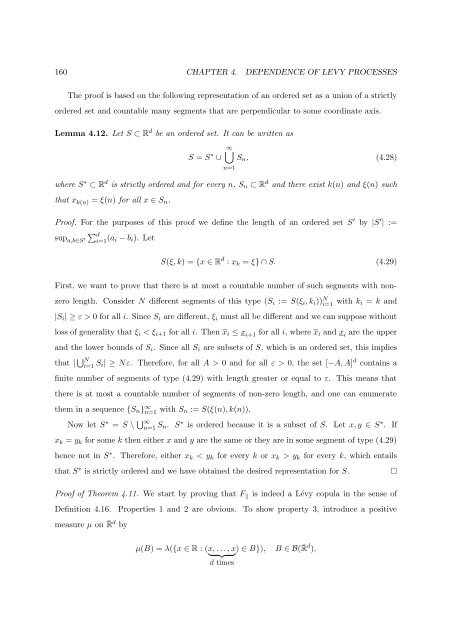Processus de Lévy en Finance - Laboratoire de Probabilités et ...
Processus de Lévy en Finance - Laboratoire de Probabilités et ...
Processus de Lévy en Finance - Laboratoire de Probabilités et ...
You also want an ePaper? Increase the reach of your titles
YUMPU automatically turns print PDFs into web optimized ePapers that Google loves.
160 CHAPTER 4. DEPENDENCE OF LEVY PROCESSES<br />
The proof is based on the following repres<strong>en</strong>tation of an or<strong>de</strong>red s<strong>et</strong> as a union of a strictly<br />
or<strong>de</strong>red s<strong>et</strong> and countable many segm<strong>en</strong>ts that are perp<strong>en</strong>dicular to some coordinate axis.<br />
Lemma 4.12. L<strong>et</strong> S ⊂ R d be an or<strong>de</strong>red s<strong>et</strong>. It can be writt<strong>en</strong> as<br />
∞⋃<br />
S = S ∗ ∪ S n , (4.28)<br />
n=1<br />
where S ∗ ⊂ R d is strictly or<strong>de</strong>red and for every n, S n ⊂ R d and there exist k(n) and ξ(n) such<br />
that x k(n) = ξ(n) for all x ∈ S n .<br />
Proof. For the purposes of this proof we <strong>de</strong>fine the l<strong>en</strong>gth of an or<strong>de</strong>red s<strong>et</strong> S ′ by |S ′ | :=<br />
∑<br />
sup d<br />
a,b∈S ′ i=1 (a i − b i ). L<strong>et</strong><br />
S(ξ, k) = {x ∈ R d : x k = ξ} ∩ S. (4.29)<br />
First, we want to prove that there is at most a countable number of such segm<strong>en</strong>ts with nonzero<br />
l<strong>en</strong>gth. Consi<strong>de</strong>r N differ<strong>en</strong>t segm<strong>en</strong>ts of this type (S i := S(ξ i , k i )) N i=1 with k i = k and<br />
|S i | ≥ ε > 0 for all i. Since S i are differ<strong>en</strong>t, ξ i must all be differ<strong>en</strong>t and we can suppose without<br />
loss of g<strong>en</strong>erality that ξ i < ξ i+1 for all i. Th<strong>en</strong> x i ≤ x i+1 for all i, where x i and x i are the upper<br />
and the lower bounds of S i . Since all S i are subs<strong>et</strong>s of S, which is an or<strong>de</strong>red s<strong>et</strong>, this implies<br />
that | ⋃ N<br />
i=1 S i| ≥ Nε. Therefore, for all A > 0 and for all ε > 0, the s<strong>et</strong> [−A, A] d contains a<br />
finite number of segm<strong>en</strong>ts of type (4.29) with l<strong>en</strong>gth greater or equal to ε. This means that<br />
there is at most a countable number of segm<strong>en</strong>ts of non-zero l<strong>en</strong>gth, and one can <strong>en</strong>umerate<br />
them in a sequ<strong>en</strong>ce {S n } ∞ n=1 with S n := S(ξ(n), k(n)).<br />
Now l<strong>et</strong> S ∗ = S \ ⋃ ∞<br />
n=1 S n. S ∗ is or<strong>de</strong>red because it is a subs<strong>et</strong> of S. L<strong>et</strong> x, y ∈ S ∗ . If<br />
x k = y k for some k th<strong>en</strong> either x and y are the same or they are in some segm<strong>en</strong>t of type (4.29)<br />
h<strong>en</strong>ce not in S ∗ . Therefore, either x k < y k for every k or x k > y k for every k, which <strong>en</strong>tails<br />
that S ∗ is strictly or<strong>de</strong>red and we have obtained the <strong>de</strong>sired repres<strong>en</strong>tation for S.<br />
Proof of Theorem 4.11. We start by proving that F ‖ is in<strong>de</strong>ed a Lévy copula in the s<strong>en</strong>se of<br />
Definition 4.16. Properties 1 and 2 are obvious. To show property 3, introduce a positive<br />
measure µ on ¯R d by<br />
µ(B) = λ({x ∈ R : (x, . . . , x) ∈ B}), B ∈ B(¯R d ),<br />
} {{ }<br />
d times
















